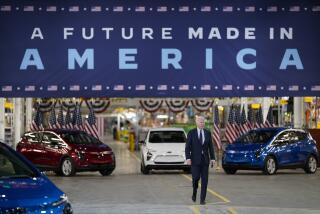Deal boosts chances for mileage rise
WASHINGTON â Congressional negotiators reached agreement Friday night on a measure calling for the biggest boost in motor vehicle fuel-economy standards in decades.
The legislation would raise the average fuel efficiency for new cars and light trucks to 35 miles per gallon by 2020. The current average standards are 27.5 mpg for cars and 22.2 mpg for light trucks, which include SUVs, pickups and minivans.
The deal reflects a major political shift on Capitol Hill, where for years allies of the automobile industry have blocked an increase in the standards. The accord also clears the way for a final vote in Congress on an energy bill that has gained political urgency as gasoline prices have surged.
House Speaker Nancy Pelosi (D-San Francisco), who has made passage of the bill a major goal, announced the agreement after days of tense negotiations with Rep. John D. Dingell (D-Mich.).
Dingell, the dean of the House and a political friend of car manufacturers, long has been an obstacle to higher fuel-efficiency standards.
Pelosi said the tougher rules represent âthe cornerstoneâ of the energy bill -- the first major concrete response by her par- ty to heightened concerns about gasoline costs, global warm- ing and U.S. dependence on foreign oil since Democrats won control of Congress a year ago.
Sen. Dianne Feinstein (D-Calif.), a leading proponent of the higher mileage standards, called the deal âhistoricâ and âthe culmination of years of hard work.â
David Friedman of the Union of Concerned Scientists said the agreement âbreaks 30 years of gridlock on fuel economy.â
House-Senate negotiators planned to work through the weekend to nail down other parts of the bill, including a requirement for adding greater amounts of home-grown alternative fuels, including ethanol, to the nationâs gasoline supply.
The bill, with its emphasis on promoting energy efficiency and development of cleaner alternative fuels, stands in sharp contrast to legislation passed in 2005 by the Republican-controlled Congress. That measure tilted toward increasing domestic production of oil, coal, natural gas and and nuclear power.
The Democratic-sponsored legislation is expected to clear the House, but could face trouble in the Senate if, as anticipated, it includes a controversial provision that would mandate utilities generate a greater amount of electricity from solar and wind power.
Several senators have said they would oppose that provision out of concern it could drive up utility costs. And some GOP lawmakers have said the bill does not do enough to increase domestic oil and natural gas production.
It also is unclear whether President Bush would sign the bill if it passed Congress.
The agreement on fuel economy comes as lawmakers from both parties have become jittery that gasoline prices will become a hot issue in the 2008 campaign.
The proposed hike in the standards would be by far the largest since the rules were first set in 1975, an action that followed an embargo by Arab oil producers.
Under the agreement, beginning in 2011, the National Highway Traffic Safety Administration would annually increase the standards to achieve the 35 mpg mark by 2020.
Automakers would be required to place a label on each vehicle that includes information on its fuel economy and greenhouse gas and other emissions.
Previous efforts in recent years to pass much stricter standards have run into resistance not only from Bush and Republicans wary of government regulation, but also Democrats -- such as Dingell -- from auto-producing states.
These foes have warned that a significant increase in the fuel rules could lead to lighter, less-safe vehicles, deny consumers the choices in vehicles they want and damage an important sector of the economy.
But those who have followed the congressional debate over the years say that, along with the growing worries about global warming, steps by California and other states to reduce greenhouse gas emissions from ve- hicles helped spur Fridayâs accord.
--







